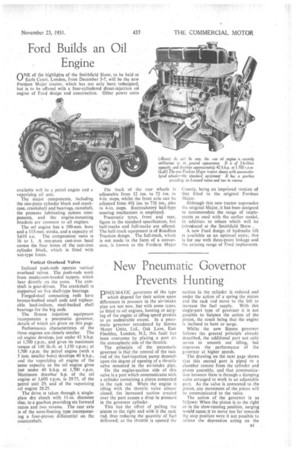Ford Builds an Oil Engine
Page 35

If you've noticed an error in this article please click here to report it so we can fix it.
available will be a petrol engine and a vaporizing oil unit_ The major components, including the one-piece cylinder block and crankcase, crankshaft and bearings, camshaft, the pressure lubricating system components, and the engine-mounting brackets are common to all engines.'
The oil engine has a 100-mm. bore and a 115-mm. stroke, and a capacity of
3,610 c.c. The compression ratio is 16 to 1. A one-piece cast-iron head covers the four bores of the cast-iron cylinder block, which is fitted with wet-type liners.
Vertical Overhead Valves Inclined push-rods operate vertical overhead valves. The push-rods work from mushroom-headed tappets, which bear directly on the cams. The camshaft is gear-driven. The crankshaft is supported on five shell-type bearings.
Forged-steel connecting rods have bronze-bushed small ends and replaceable lead-indium, steel-backed Shell. bearings for the big ends.
The Simms injection equipment incorporates a pneumatic governor, details of which are given on this page.
Performance characteristics of the three engines are closely similar. The oil engine develops just under 42 b.h.p. at 1,700 r.p.m., and gives its maximum torque of 140 lb.-ft. at 1,150 r.p.m.; at 1,700 r.p.m. the petrol engine (with a 5 -ram. smaller bore) develops 40 b.h.p., and the vaporizing oil engine of the same capacity as the oil engine gives just under 40 b.hp, at 1,700 r.p.m. Maximum 'drawbar h.p. of the oil engine at .1,600 r.p.m. is 29.75, of the petrol unit 29, and of the vaporizing oil engine 28.25.
The drive is taken through a singleplate dry clutch with I1-in, diameter 'disc, to a gearbox providing six forward ratios and two reverse. The rear axle is of the semi-ffoating type incorporating a four-pinion differential on the countershaft. The track of the rear wheels is adjustable from 52 ins. to 72 ins. in 4-in. steps, whilst the front axle can be adjusted from 491 ins. to 73f ins., also in 4-in. steps. Recirculatory steering mechanism is employed.
Pneumatic tyres, front and rear, figure in the standard specification, hut half-tracks and full-tracks are offered. The half-track equipment is of Roadless Traction design. The full-track, which is not madein the form of a conversion, is known as the Fordson Major County, being an improved version of that fitted to the original Fordson Major.
_ Although this new tractor supersedes the original Major, it has been designed to accommodate the range of implements as used with. the earlier model, in addition to others which will be introduced at the Smithfield Show, .
A new Ford design of hydraulic lift is available as an optional extra; this is for use with three-point linkage and the existing range of Ford implements.












































































